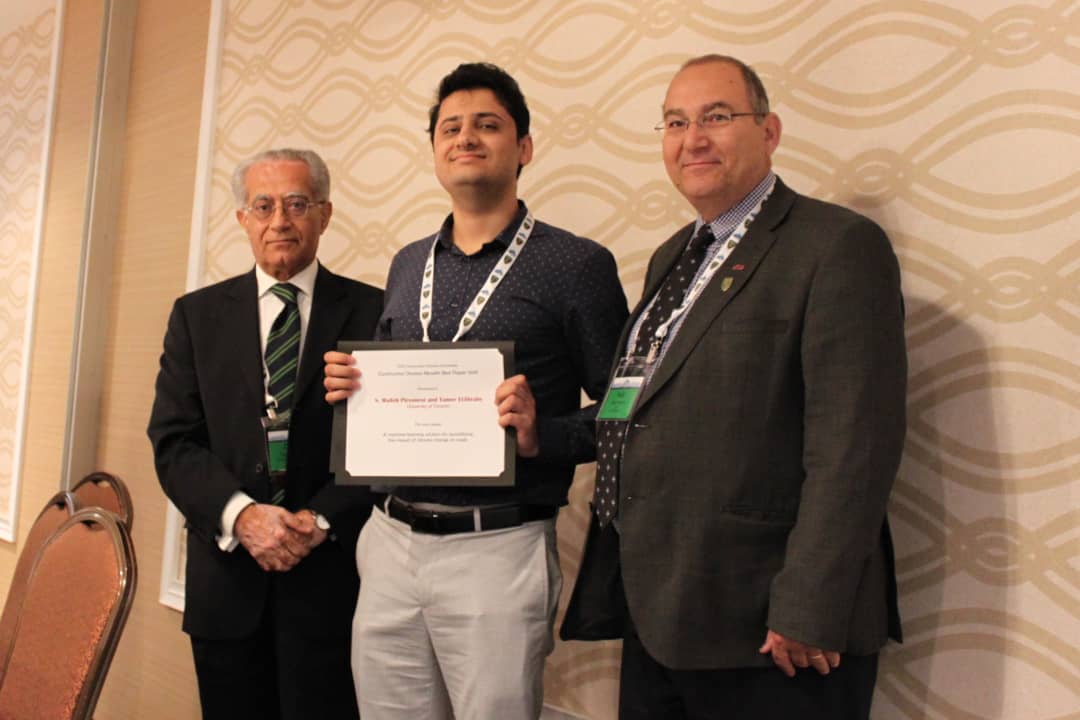Road management, the climate crisis, and machine learning are three things which may not seem connected, but they do to Dr. Madeh Piryonesi, a University of Toronto civil engineer who defended his PhD this year.
This June, one of his papers, co-authored by Professor Tamer El-Diraby at U of T’s Department of Civil & Mineral Engineering, titled “A Machine-Learning Solution for Quantifying the Impact of Climate Change on Roads,” won the Moselhi Best Paper Award at the Canadian Society for Civil Engineering’s annual conference. Piryonesi created a model to predict how roads would deteriorate due to change in climate, and implemented it as an online tool that will be accessible to policymakers.
Piryonesi’s research has been funded by the Natural Sciences and Engineering Research Council and the Ontario Good Roads Association.
How roads may be impacted by the climate crisis
In Piryonesi’s model, users are treated to a visual interface where they can input a road’s name and see that road pop up on Google Maps. They can then enter the parameters for a future climate — such as an increase in temperature and precipitation — and see the projected future deterioration of the road.
The model can make predictions for roads in many locations, thanks to the wealth of data Piryonesi had access to. His machine-learning algorithms were trained on data provided by the Long-Term Pavement Performance program, which is managed by the US Federal Highway Administration. The program stores data — including traffic and weather information — on more than 2,500 road sections across Canada and the US, and dates back over 30 years.
“Using this very well-spread data kind of makes sense for climate change analysis,” said Piryonesi to The Varsity.
The model’s predictions depended strongly on location. He tested the tool on roads in both Texas and Ontario. While it projected that, in a certain climate-change scenario, roads in Texas would be badly hit, it actually predicted that some roads in Ontario would fare better with a change in climate than without.
Piryonesi stressed that this doesn’t mean the climate crisis is good for Ontario roads, only that, under the model’s specific assumptions, Ontarian roads should not be badly damaged.
Nevertheless, the model highlights how the climate crisis varies by region.
The theory behind Piryonesi’s work
Many models already exist for predicting road quality in order to aid municipal governments in maintaining their infrastructure. However, Piryonesi diverged from most previous work in two ways.
While existing models use a variety of techniques, the use of machine learning in road modelling is relatively new. Tailoring these models to incorporate changes in climate is also novel.
Piryonesi explained that the reason this interesting combination is useful is that change in climate is inherently a stochastic process — that is, it involves randomness.
According to Piryonesi’s paper, this puts deterministic models, which spit out a single value, at a disadvantage compared to models that can consider a range of possibilities and predict their likelihoods. Machine learning falls into the latter category.
At its core, Piryonesi’s work is based on a decision tree algorithm. In everyday life, decision trees — a kind of flowchart — let us visualize how outcomes or costs depend on sequences of events that take place.
In machine learning, decision tree algorithms are fed existing data, learn from it, and reverse-engineer a decision tree that predicts unknown data. To amplify the low accuracy of a single decision tree, Piryonesi’s model also uses ‘bagging,’ a process in which hundreds or thousands of ‘learners’ construct separate trees, and then hold a ‘vote’ on the best one.
This approach can produce predictions that are not single numbers. “If our model has five outcomes, being the road staying in good condition, medium, and so on,” said Piryonesi, “the tool can give you, for example, a probability of 98 per cent good and the two per cent being in the other conditions.” Deterministic models can’t make these probabilistic predictions.
However, Piryonesi is aware that some users do not see this as advantageous. “Most customers or most municipalities that we are working with are using deterministic tools,” he commented. “The problem is, they don’t get the notion of probability and probabilistic things; they want one number.”
In Piryonesi’s opinion, industries and academia alike should better communicate the fact that everything in the real world is probabilistic.
“Having a probability doesn’t mean that it’s bad; [only] that we are not sure,” he said.
The impact of the tool’s findings
The findings were interesting to Piryonesi for two reasons. For one, understanding how badly roads are affected by changes in climate compared to other types of infrastructure can inform governments on what infrastructure demands the most attention and funding.
Climate justice also interests him. He sees value in determining quantitatively which regions would be hit worst by the climate crisis. “I think this could be a good basis for carbon pricing, for tax.”
Although change in climate was not originally his area of expertise, he was drawn to it because he saw the need for more evidence-based research.
“Politicians, men of religion, everyone, people on the street, they talk about [the climate crisis]. And oftentimes they have anecdotes [but] they’re not super accurate,” he said. “So I thought maybe I would want to touch a little on this [topic].”


